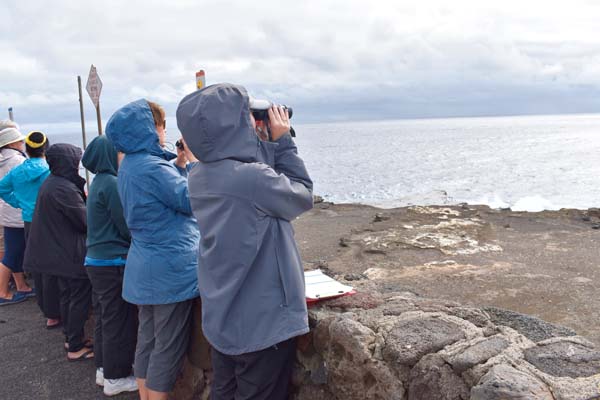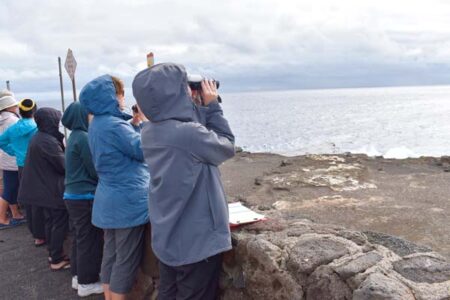Heavy rains impact annual Great Whale Count

As 264 volunteers gathered data from the shores of Kauai, Oahu and Hawaii islands during the Hawaiian Islands Humpback Whale National Marine Sanctuary Ocean Count, the first of three coordinated whale counts in 2023, the Great Whale Count by Pacific Whale Foundation on Maui was only able to report from one of 12 designated sites due to ongoing heavy rain. Sarah Hutchinson / NOAA photo
The Maui News
Rain and storms across Hawaii, especially on Maui, caused poor visibility for volunteers and halted many Sanctuary Ocean Count and Great Whale Count observation sites on Saturday.
As 264 volunteers gathered data from the shores of Kauai, Oahu and Hawaii islands during the Hawaiian Islands Humpback Whale National Marine Sanctuary Ocean Count, the first of three coordinated whale counts in 2023, the Great Whale Count by Pacific Whale Foundation on Maui was only able to report from one of 12 designated sites due to ongoing heavy rain.
“Across the main Hawaiian Islands, weather conditions were not ideal and made it difficult for observing whales from the shoreline due to poor visibility caused by rain and strong winds,” the news release said.
Still, the single Great Whale Count site on Maui was able to report 41 whales. Specifically, a total of nine whales were observed during the 10 to 10:15 a.m. time period, the most of any time period throughout the day’s count.
Precautionary measures were taken to ensure the safety of volunteers and site leaders once heavy rains began.
On Kauai, the total number of whales observed during the day’s count was 94; on Oahu, the total was 246; and Hawaii island had 206. Adding in Maui’s 41 whale sightings, there was a total of 587 throughout the state.
According to a news release, volunteers collected data from 30 sites across the main Hawaiian islands on Saturday. A total of 83 whales were observed during the 9 to 9:15 a.m. time period statewide, the most of any time period throughout the day’s count.
On Kauai, Oahu, and Hawaii island, Ocean Count volunteers collected data from 29 sites. A total of 75 whales were observed during the 9 to 9:15 a.m. time period, the most of any time period throughout the day’s count.
This number may represent duplicate sightings of the same whale by different observers or at different time periods or different locations throughout the day, the news release noted.
Data collected during the Sanctuary Ocean Count and Great Whale Count combined with other research efforts can help reveal trends in humpback whale occurrence within whale seasons.
A variety of other species were also spotted during the count, including green sea turtles, spinner dolphins and multiple seabird species, such as ‘iwa (great frigatebird), moli (Laysan albatross), kolea (Pacific golden plover), ‘ua’u kani (wedge-tailed shearwater), koa’e kea (white-tailed tropicbird) and more.
Ocean Count promotes public awareness about humpback whales, Hawaiian Islands Humpback Whale National Marine Sanctuary, and shore-based whale watching opportunities.
Site leaders tally humpback whale sightings and document the animals’ surface behavior during the survey, which provides a snapshot of humpback whales’ activity.
Ocean Count is supported by the National Marine Sanctuary Foundation.
The Great Whale Count by Pacific Whale Foundation had site leaders count whales from shore as part of a long-term survey of humpback whales in Hawaii, with survey sites along the shoreline of Maui.
This event provides a snapshot of trends in relative abundance of whales and is one of the world’s longest-running community science projects, the news release said.
Both counts take place three times during peak whale season annually on the last Saturday in January, February, and March.
The next Great Whale Counts on Maui is set for Feb. 25 and March 25.
For more information or to view data, visit https://www.pacificwhale.org/research/community-science/.
- As 264 volunteers gathered data from the shores of Kauai, Oahu and Hawaii islands during the Hawaiian Islands Humpback Whale National Marine Sanctuary Ocean Count, the first of three coordinated whale counts in 2023, the Great Whale Count by Pacific Whale Foundation on Maui was only able to report from one of 12 designated sites due to ongoing heavy rain. Sarah Hutchinson / NOAA photo






